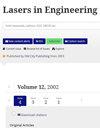Formation of embedded nanoparticles in an excimer laser treated Mg alloy surface
IF 0.5
4区 工程技术
Q4 MATERIALS SCIENCE, MULTIDISCIPLINARY
引用次数: 2
Abstract
The surface melting characteristics of AZ91 alloy is investigated using excimer laser (pulses of length 45 ns) under ambient conditions and also a N 2 environment. Experiments are carried out on overlapping spots with close interval. The melt layer hardness for treatment in air is increased to 162 VHN as compared to 73 VHN for the untreated alloy (AZ91 T4 condition), whereas the hardness of the sample treated in an N 2 atmosphere is 116 VHN. A transmission electron microscopy study reveals that the laser treated surface contains nanoparticles of oxide and nitride embedded in the submicron grains of the Mg solid solution. This is responsible for the observed high hardness which gives rise to the improved abrasive resistance. We propose a model to describe the formation of nanoparticles during the laser treatment.准分子激光处理镁合金表面中嵌入纳米颗粒的形成
利用准分子激光(脉冲长度为45 ns)研究了AZ91合金在常温和n2环境下的表面熔化特性。在间隔较近的重叠点上进行了实验。与未处理合金(AZ91 T4条件)的73 VHN相比,在空气中处理的熔体层硬度增加到162 VHN,而在n2气氛中处理的样品的硬度为116 VHN。透射电镜研究表明,激光处理后的表面含有氧化物和氮化物纳米颗粒,嵌入在Mg固溶体的亚微米颗粒中。这是观察到的高硬度的原因,从而提高了耐磨性。我们提出了一个模型来描述激光治疗过程中纳米颗粒的形成。
本文章由计算机程序翻译,如有差异,请以英文原文为准。
求助全文
约1分钟内获得全文
求助全文
来源期刊

Lasers in Engineering
工程技术-材料科学:综合
CiteScore
1.00
自引率
20.00%
发文量
0
审稿时长
3.4 months
期刊介绍:
Lasers in Engineering publishes original (primary) research articles, reviews, short communications and letters on all aspects relating to the application of lasers in the many different branches of engineering and related disciplines.
The topics covered by Lasers in Engineering are the use of lasers: in sensors or measuring and for mapping devices; in electrocomponent fabrication; for materials processing; as integral parts of production assemblies; within the fields of biotechnology and bioengineering; in micro- and nanofabrication; as well as the materials and processing aspects of techniques such as cutting, drilling, marking, cladding, additive manufacturing (AM), alloying, welding and surface treatment and engineering.
Lasers in Engineering presents a balanced account of future developments, fundamental aspects and industrial innovations driven by the deployment of lasers. Modern technology has a vitally important role to play in meeting the increasingly stringent demands made on material and production systems. Lasers in Engineering provides a readily accessible medium for the rapid reporting of new knowledge, and technological and scientific advances in these areas.
 求助内容:
求助内容: 应助结果提醒方式:
应助结果提醒方式:


